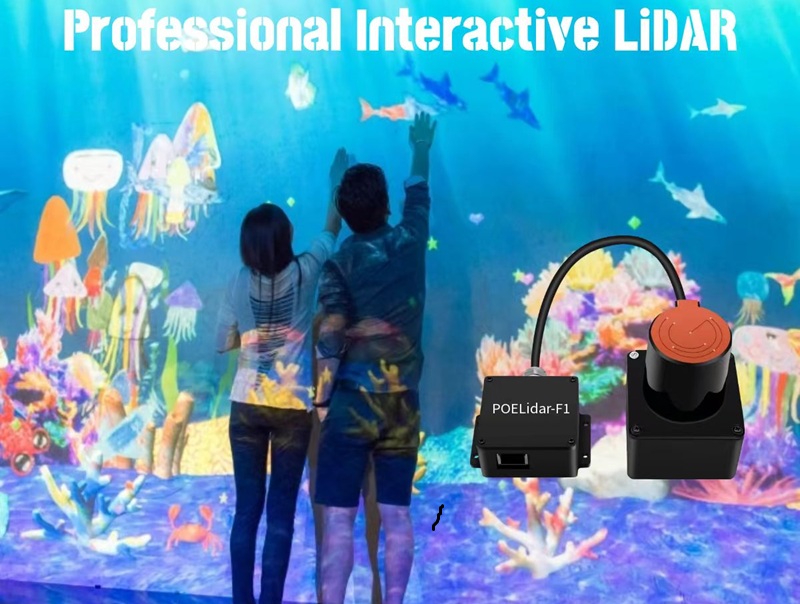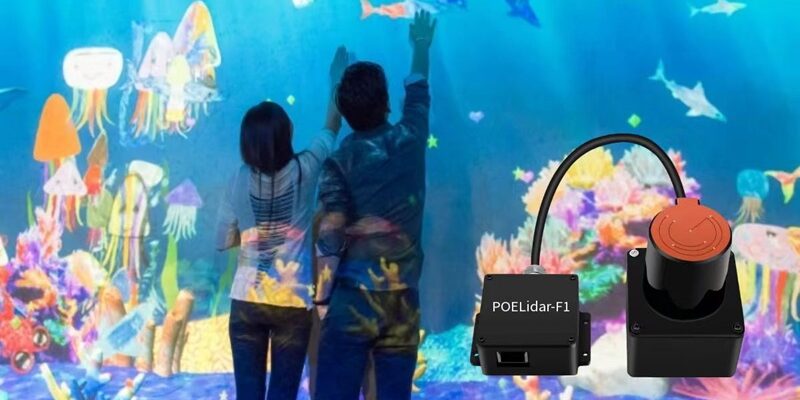In today’s ever-evolving world of technology, LiDAR (Light Detection and Ranging) has found remarkable applications across various industries. One of the most captivating implementations of this technology is the interactive wall, where LiDAR sensors combine with projection systems to create immersive, hands-on experiences for users. These interactive walls are transforming the way visitors engage with exhibitions, museums, and even commercial spaces. This article delves into the technology, benefits, and applications of LiDAR-based interactive walls, exploring how they are reshaping interactive experiences.

What is LiDAR Interactive Wall Technology?
LiDAR technology, which uses laser pulses to measure distances and create highly accurate spatial data, is now at the forefront of interactive systems. In an interactive wall setup, LiDAR sensors are used to detect gestures, touch, and movements in real-time, enabling seamless interaction between users and displayed content.
Key Components of LiDAR Interactive Walls
- LiDAR Sensors
LiDAR sensors are installed on the walls or ceilings of exhibition spaces to capture the position and movements of individuals. These sensors can detect multiple touchpoints simultaneously, enabling multi-touch interaction without direct physical contact. Unlike traditional touchscreens, LiDAR systems are unaffected by ambient light, making them effective in low-light or dimly lit environments. This flexibility makes LiDAR an excellent choice for various installation settings. - Projection System
A high-resolution projector is the second vital component. It projects dynamic visuals, such as images or animations, onto the interactive wall. The content is responsive to user interaction. For instance, when a person touches or moves near the wall, the projection system reacts by altering images, playing sounds, or initiating other effects, making the experience engaging and fluid. - Interactive Software
The third component is the software platform that powers the interaction. This software processes the data from the LiDAR sensors and controls how the projection system behaves in response to user inputs. It can support various interactive modes, such as games, educational displays, and interactive media, offering endless possibilities for customization based on exhibition needs.

Advantages of LiDAR Interactive Walls
Multi-Touch and Gesture-Based Interactions
One of the standout features of LiDAR-based interactive walls is their ability to support multi-touch and gesture-based interactions. Traditional touchscreens often limit the number of interactions that can occur at once. However, LiDAR sensors can detect hundreds of touchpoints, allowing multiple users to interact with the wall simultaneously. This enhances the user experience, as it supports dynamic, collaborative environments where users can engage with content collectively.
Non-Contact Interaction
LiDAR technology supports non-contact interaction, which adds a layer of convenience and hygiene. Users do not need to physically touch the surface to trigger responses; a simple wave of the hand or movement near the wall can activate the content. This makes the interactive experience feel more natural, intuitive, and hygienic, especially in high-traffic public spaces such as museums, malls, and healthcare facilities.
Enhanced Environmental Adaptability
Unlike infrared-based or camera-based systems, LiDAR technology works reliably in various lighting conditions. Whether in brightly lit environments or dark spaces, LiDAR sensors continue to operate with precision, making them suitable for a range of exhibitions and public installations. This characteristic ensures that the user experience is consistent regardless of environmental conditions.
Flexible and Customizable Installations
Another significant advantage is the flexibility and customizability of LiDAR-based systems. The sensors are compact and can be easily installed on different types of surfaces. Moreover, multiple units can be combined to expand the interaction area, making it possible to create larger installations or cover more space within an exhibition hall.
Rich Interactive Content
LiDAR-based interactive walls support a diverse range of interactive content. From images, videos, and audio to interactive games and educational displays, the possibilities are virtually endless. This versatility makes these systems suitable for various applications, including entertainment, education, advertising, and more.
Applications of LiDAR Interactive Walls
1. Museums and Exhibitions
LiDAR interactive walls are becoming increasingly popular in museums and exhibitions where engaging and educating the audience is a primary goal. Visitors can interact with the displayed content, whether it is historical artifacts, scientific information, or creative displays. This immersive interaction not only captivates attention but also helps enhance knowledge retention.
For example, an art museum could use an interactive wall to display digital renditions of famous paintings. As visitors move closer, the wall could showcase additional information about the artwork or display an augmented reality version of the painting in a new light.
2. Commercial and Corporate Spaces
LiDAR interactive walls are making their mark in commercial spaces such as shopping malls, hotels, and corporate offices. These installations can be used for interactive advertisements, product showcases, or customer engagement initiatives. By integrating LiDAR projection technology, companies can provide interactive digital signage that captures the attention of passersby and invites them to engage in a hands-on experience.
At a car dealership, for instance, an interactive wall could allow customers to customize the vehicle they are interested in and view real-time visualizations of their choices on the wall.
3. Retail and Shopping Centers
In retail environments, LiDAR interactive walls offer a futuristic approach to customer interaction. Customers can browse product catalogs, view product information, or play interactive games that promote certain products or services. Retailers benefit by offering an engaging experience that not only entertains but also increases customer engagement and sales.
4. Children’s Play Areas
Children’s museums or play areas can also benefit from LiDAR-based interactive walls. By using interactive elements, children can learn through play, such as by triggering fun animations or sounds through their gestures. These interactive systems can make learning about science, nature, or art more exciting and memorable for young audiences.
5. Corporate Events and Conferences
For conferences or corporate events, LiDAR projection systems can be used to create unique, memorable presentations. Interactive walls can be employed to showcase data visualizations, highlight event details, or even allow participants to engage with the content during a live session. This engagement fosters a deeper connection to the event and enhances overall attendee experience.
Real-World Case Studies
Case Study 1: Interactive Touch Wall at a Bank
One of the most notable applications of LiDAR-based interactive walls is in the banking industry. A leading bank used LiDAR technology to create a touch-sensitive wall for customer engagement at one of their branches. Customers could interact with the wall to learn more about the bank’s products and services. The content displayed responded in real-time to touch and gestures, enhancing customer interaction and satisfaction.
Case Study 2: Automotive Trade Show Interactive Wall
At an international auto show, a renowned car manufacturer employed a LiDAR interactive wall to allow visitors to explore new vehicle models. The system enabled attendees to zoom in on different car features and customize the vehicle’s look, all while receiving dynamic, visual feedback via projections. The interactive experience drew crowds and provided a cutting-edge way for customers to explore their options.
The Future of LiDAR-Based Interactive Walls
As LiDAR technology continues to evolve, its applications in interactive systems will expand further. With advancements in AI, LiDAR projection systems could incorporate even more sophisticated features, such as personalized content delivery based on user demographics or preferences. Additionally, the continued improvement in sensor accuracy and miniaturization will make these systems more cost-effective and easier to integrate into everyday environments.
The potential for LiDAR-based interactive walls in creating immersive, engaging experiences is vast, and the future holds endless possibilities.
Conclusion
LiDAR interactive walls are revolutionizing the way we interact with digital content in exhibition spaces, retail environments, museums, and corporate settings. By combining LiDAR sensor technology with projection systems, these interactive walls offer users a dynamic, engaging, and immersive experience. As the technology continues to evolve, we can expect even more advanced features and applications, cementing LiDAR’s role as a key player in the interactive technology space.
By leveraging LiDAR projection and interactive wall systems, businesses and institutions can create memorable experiences that captivate audiences, foster engagement, and drive success in both commercial and educational environments.







